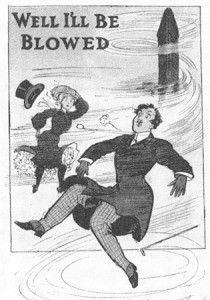… Like “amscray,” “cheese it,” or “beat it,” “23 skidoo” is an American slang phrase dating from the early part of the 20th century that is associated with leaving a difficult, dangerous, or tricky situation quickly.
For example: ”Let’s 23 skidoo before the cops come!” Or: “Hey, youse two … 23 skidoo! I don’t wanna see yer mugs in this saloon no more.”

The Beginning.
The use of “23 skidoo” caught on as a nationwide fad starting in1906, and remained somewhat popular at least up into my childhood in the 50’s. I still remember my parents using it with my sister and me to get us moving promptly –“Okay kids, 23 skidoo into the car or we’ll be late for grandma’s.”
And while use of “23 skidoo” has pretty much faded by now, there is still one place – one mega-city in fact – where plenty of people of all ages are still familiar with the phrase and are more than happy to tell you about how the expression came about.

Though this short film predates the Flatiron building by a year or so, it does illustrate that time period’s predilection for a certain type of female sartorial mishap. “Skirt blowing action” begins about one minute into this short film by Thomas A. Edison’s studio.
The Flatiron Building.
Ask almost any New Yorker, and they’ll inform a newcomer that “23 skidoo” has everything to do with Manhattan’s Flatiron Building, a triangular 22-story skyscraper built in 1902.
The Flatiron Building, an impressive structure then and now, is located on 23rd Street at the confluence of Fifth Avenue and Broadway. Because of the building’s shape, the open spaces of Madison Square Park (which it faces), and the sharp angles of the building-lined streets that border it, the Flatiron Building — till this day — experiences a continual, ever-shifting swirl of high winds and downdrafts.

How Windy is This Location?
Windy enough to attract idle groups of young men who, back in the day, would wait to catch sight of a lady’s well-turned ankle or leg exposed by the gusts.
Police would be called. And then New York’s finest would proceed to break up the gawking males with cries of “23 skidoo!” — with “23” for 23rd Street, and “skidoo” a derivative of the slang word “skedaddle,” meaning to leave abruptly.
Hence, the Origin of the Expression.
Hmm. Or so the story goes. Most web sites concerning idioms claim the above story is based on urban legend more than anything else and only offer vague alternative explanations for “23 skidoo.”
But like my fellow New Yorkers, I’ll still stick to the meteorological account for the phrase; it has everything Big Apple dwellers like in a story – Naughtiness! History! Law-breakers! Cops! And tall buildings.

Credits for above photo: Keith Godard, mosaic artist; photo via Justin Ferate from the website untappedcities.com